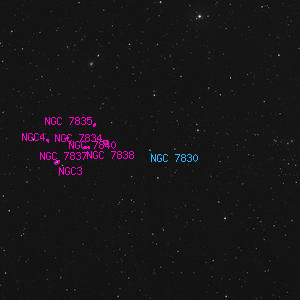NGC 7830

Overlaid DSS image of NGC 7830, 60' x 60' with north at top and west to the right
Aladin viewer for the region around NGC 7830
| Type | Star |
|---|---|
| Magnitude | Right Ascension | 0h 6' 1.9" (2000) |
| Declination | 8° 20' 34" N |
| Constellation | Pisces |
| Description | eF, neb * 13 m |
Observing Notes
Harold Corwin
Just a week ago (in May 2016), I wrote:
There is nothing obvious in Marth's place, but his group including NGC 3, 4, 7834, 7835, 7837, and 7840 are all near their listed positions. Given that he found all of these on the same night, and verified all but two of them (NGC 4 and NGC 7840), it is very unlikely that NGC 7830 is a duplicate of any of them.
Then I took a look at my note for NGC 4. So just how bright is it? And how does it compare with NGC 7830?
Reading on in my note a bit, I found that I had written this about NGC 7830:
What is near Marth's position -- in fact, nearly coincident with it -- is an extremely faint star with two (or perhaps three) fainter galaxies just north. I'm prepared to say that Marth could not have picked this up even with Lassell's 48-inch, let alone called it "eF, neb * 13 m". The "eF" I can deal with, but not the "13 m". The star and the galaxies have a total V magnitude of 15.7, almost certainly too faint to have been picked up sweeping. Finally, I note that another galaxy in the area that Marth found the same night, NGC 7834, has V = 15.0 -- he called it "eeF".
At this point, I calculated the magnitude of NGC 4 from the SDSS data and found it to be V = 15.5 (the SDSS image apparently includes a star with V = 20.0). So, I hereby retract my previous words on NGC 7830. Marth probably could have seen the faint "nebulous" star. I'm still not happy about Marth's estimated magnitude, but that may represent in his mind the faintest object that he could see, just as Bigourdan set 13.5 as his magnitude limit. So, I'm changing the question marks to colons to reflect my lingering doubt that this might not be Marth's object. But could he have seen it? With a 48-inch telescope, almost surely.
Here is the rest of my NGC 7830 note concerning the IC2 Note on the object.
In the IC2 Notes, Dreyer cites an RA correction by Bigourdan. Reducing Bigourdan's observation, however, leads to 00 06 00.0, +08 22 19 (J2000) -- there is nothing in that position. This assumes that his comparison star is UCAC4 492-000201, the brightest of the stars in the area of Bigourdan's estimated place for the star. He gives an offset from BD +7 5129 of +0m 40s, -4' which leads us to the UCAC star. Coincidentally, this is the same star that I chose for NGC 7830 many years ago. It has a fainter companion at 00 06 01.2, +08 19 54; this is UCAC4 492-000200. But neither of these is near Marth's position, and it's clear that Bigourdan was "seeing" another of his "fausse images" when he "measured" what he took to be Marth's object. So, we can ignore the IC Note.
While I am not entirely happy with this how this has played out, the star with its background galaxies, probably is Marth's object.
Other Data Sources for NGC 7830
Nearby objects for NGC 7830
13 objects found within 60'
| 31 Piscium | c Piscium | HD 225057 |
| NGC 7816 | NGC 7818 | NGC 7834 |
| NGC 7835 | NGC 7837 | NGC 7838 |
| NGC 7840 | NGC3 | |
| SAO 108988 |
Credits...
Drawings, descriptions, and CCD photos are copyright Andrew Cooper unless otherwise noted, no usage without permission.
A complete list of credits and sources can be found on the about page
NGC 7830